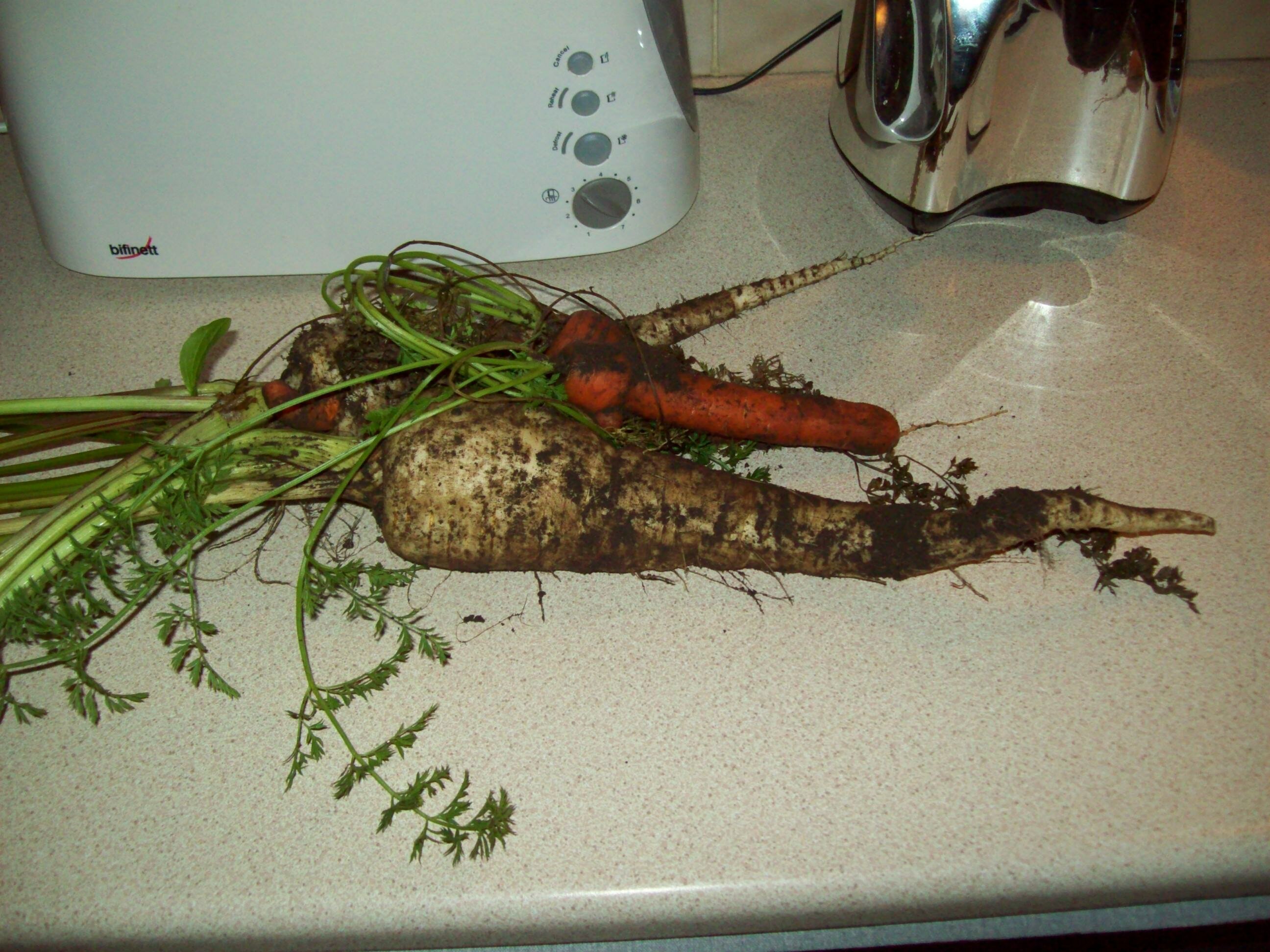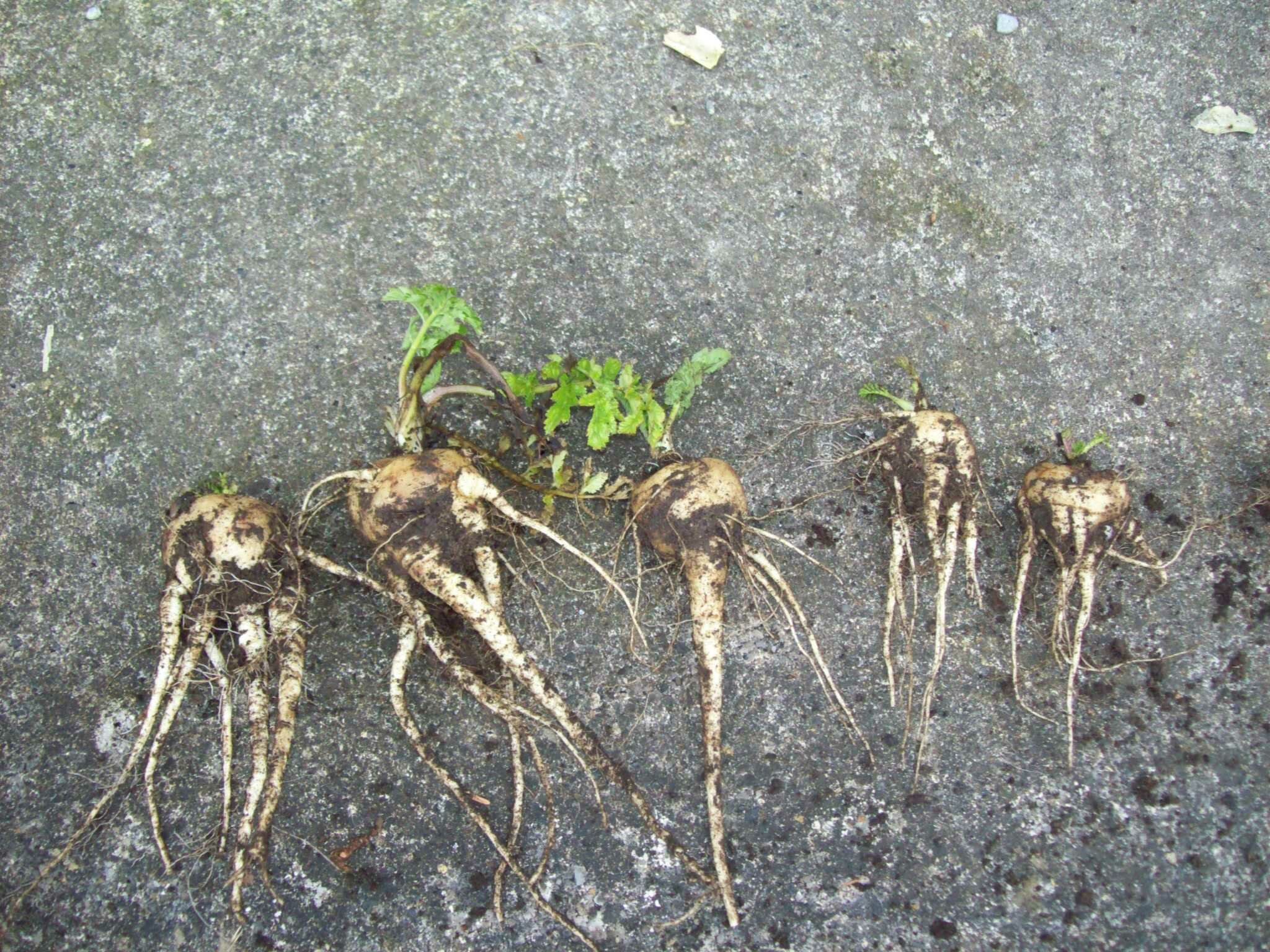Parsnip growing - Parsnip how to grow, tips, varieties, cooking.
The nation is split on parsnips. On one side you have, let’s call them the parsnip-phobes, the group who believe this vegetable to be nothing but the basis for a bland soggy mash. Then on the other side you have the parsnip-philes who view them as a easy grow vegetable, one which will add a warm nutty flavour to stews or conversely bring forth sweetness when roasted.
Where do you stand on the issue? Well, to truly test yourself you should try you hand at growing your own. Once you bring them fresh from garden to table you may see a whole different side to humble parsnip.
Common names:
Parsnip
Forked parsley
Devils carrot
Botanical name:
Pastinaca sativa.
Origin:
Mediterranean regions of Europe.
Brief description:
Parsnips usually have a long tapered root, coloured creamy white. Its leaves sprout in rosettes and resemble those of celery, which is not surprising seeing as it is a member of the Umbelliferae family also comprising parsley and carrots.
Are they easy or hard to grow?
Reasonably easy to grow once soil is suitable.
Varieties suitable to grow in Ireland:
Tender and True (long roots, usually 7cm (3”) across top, good resistance to canker, little core, and great flavour)
Hollow Crown Improved (long variety, ideal for exhibition, and also kitchen use)
Gladiator (fast maturing, high yields, resistant to canker, smooth white skin, and great nutty flavour)
White Gem (medium-sized, good for shallow soils, resistant to canker, easy to lift, good flavour)
Offenham: (medium-sized, wide tops, good for shallow soils, easy to lift, and good flavour)
The Student (medium-sized, wide tops, and one of the best tasting.
Avonresister (short roots, good for shallow soils, forgiving of poor soils, resistant to canker, and sweet-flavoured
 Irish stock.
Irish stock.
 UK stock.
UK stock.
When to grow:
Normally March to Mid-May. You can even sow in Mid- February provided it is under cloches or frames.
Where to grow, and soil conditions required:
Although parsnips can tolerate partial shade they will do much better in a sunny spot.
Shelter is also beneficial. Avoid soil that waterlogs or conversely dries out rapidly.
As you are dealing with a root vegetable, deep, fertile, and slightly sandy soil is preferred. The sand aids drainage as well as allowing the soil to warm up as quickly as possible in spring. If your soil is sticky, stony, or shallow, then I suggest you instead opt for sowing short-rooted parsnip varieties.
Relative acidity or alkalinity (Ph) required:
Parsnips don’t grow very well in a strongly acid or strongly alkaline soil. This is because most essential vegetable nutrients in the soil are soluble and available for use at pH levels of 5.5 to 7.5 (slightly acid to neutral). Most vegetables grow best within this range.
If the pH (relative acidity or alkalinity) of your soil is not suited to the vegetable, then soil nutrients such as Nitrogen, Phosphorus, Potassium, iron, boron, copper, manganese and zinc start to become unavailable, leading to poor crops. In the case of parsnips, they can develop parsnip canker if the soil is too alkaline (limey).
You can use a home soil test available in most garden centres to determine your soils ph. By taking account of the test results you can then decide how much if any amendments are required to bring the to pH of your vegetable garden soil in line.
The application of ground lime will be helpful in countering the excessive acidity. As a rough rule of thumb, an application of 250g of ground lime per metre squared the autumn before planting/sowing will commonly increase your ph by about one point. However as lime is available in different formulations and soil types vary, I advise also consulting the rates set out on the pack.
If you need to decrease your ph to make the soil more acid, then you can apply sulphate of iron at a rate of 100g per metre squared for each drop in ph point. Apply this product according to the manufacturers instructions and heed safety warnings especially those concerning the use of protective clothing and equipment. An application of 2 inches of peat moss worked in to a spades depth all over the proposed growing area will also go a good way towards dropping your soil by one ph point.
Food reserves required:
For long term feeding of your crop, every 10m2 of growing area should have one wheelbarrow load of well-rotted homemade compost or farmyard animal manure spread over its surface sometime during the autumn/early winter before planting/sowing. Dig this in to a spades depth all over the proposed growing area to enrich it for your crop. Whilst digging, remove any stones and other obstacles that might cause the roots to become malformed (forking/fanging).
Important note….
Incorporate the well-rotted homemade compost or farmyard animal manure in autumn/early winter before planting/sowing, or don’t do it at all. Do not dig in fresh manure or compost as it can cause the roots to fork or fang instead of growing long and straight. The parsnips will still be fine to eat, but a pain to peel.
As a rule of thumb, well-rotted manure/compost will be over six months old, and tend to be dark brown will little if any smell. You should not be able to distinguish individual pieces of straw, hay, vegetable peelings, grass etc., as it will all be rotted down.
If unsure about the freshness of your compost or manure additions, then omit them completely when sowing your root vegetables. This will be fine as long as they are added to the soil before your next non-root vegetable crop in that location.
A week or two before sowing your seed should lightly rake a well-balanced fertilizer into your growing area. Growmore or fish blood and bone (organic option) are both suitable for this purpose. Apply according to the rates on the pack.
How to plant or sow:
The night before you intend to sow you should soak your parsnip seeds in room temperature water for several hours. This will “soften” the seed and hasten germination. Any seed not required for sowing that year should not be soaked, if kept dry it has a life expectancy of 1 year.
In your weed-free and lightly raked growing area you must create a ½ inch (1cm) deep drill/trench with the tip of your trowel. Every 6 inches (15cm) along the drill place three seeds 1inch (2.5cm) apart. Close the drill with soil, then water well and label.
Create as many drills as you like at 10-12inch (25-30cm) intervals. As a rough rule of thumb you can expect 1 to 1.5 kg of crop per metre of row, which may help you make a decision on how much to grow. The expected seed germination time approx 10-28 days.
When your seedlings are about 1in (2.5cm) high, thin them to leave a single plant at each 6-inch interval. There is no use in lifting thinnings for transplanting as they will just produce malformed roots. Instead snip them off at ground level with a scissors to prevent disturbing the remaining seedlings. Remove the thinnings from site and water the crop well afterwards.
Caring for your crop:
Keep the soil around the parsnips weed-free. Take care when weeding because the roots are easily damaged.
During a prolonged spell without rain (week or more) you should water gently but deeply once a week. As a rough rule of thumb apply approx 10 litres per metre squared of soil area. Carry out this watering in the morning and try to avoid splashing the leaves, watering the soil instead.
At about the sixth or seventh week after seed germination and while plants are growing strongly you can apply a second application of a well balanced fertiliser. Although not essential, a further scattering of Growmore or fish blood and bone can increase the vegetables vigour and make the less susceptible to plant ills. Once scattered the fertiliser should be lightly scratched into the soils surface followed by gentle but deep watering of the soil.
Pests and Diseases:
Parsnips have no real serious pest or disease problems, aside from parsnip canker. This exhibits itself as blackened areas on the roots often followed by cracks and rotting. You should not encounter this though if you follow the soil preparation, feeding and pH rules mentioned earlier.
Other troubles of parsnip include…
Splitting
Slugs and snails
Swift Moth
Fanging
Harvesting, when and how:
Time from planting to harvest is from 12 to 16 weeks. When the soil is moist you can grasp the leaves and carefully lever out the root from beneath with a hand fork, then shake off the soil.
Lift the parsnips as required, leaving the rest in the soil until you require them. Harvesting can continue right up until early March the following year. Any incidences of frost whilst your parsnips are in the ground will only increase their sweetness by converting the roots starch to sugar.
Storage:
For short-term storage (one to three weeks), place parsnips in the salad crisper compartment of your refrigerator.
Longer-term, the beet roots themselves will keep for up to six months in a area which is cool (2-4 degrees centigrade), dark and away from strong flavours or scents. Place individual layers of parsnips in slatted boxes, surrounding each individual vegetable with dry peat, paper or hay, with two more layers of parsnips allowed to follow on top provided you ensure that buffer of dry peat, paper or hay.
Another storage option is to peel and cut the parsnips into cubes, boil for five minutes, remove and place under cold water, then freeze in plastic bags. This will allows you to store them for approx six months.
However, I have to say when your parsnips store so well in their growing location, why would you go to the trouble of storing them any other way? I suppose if you required the ground for something else would be one possible reason for storing them otherwise.
Cooking:
To cook, simply peel, slice and boil for ten to twenty five minutes in lightly salted water. Alternatively you can steam parsnips for about 45 minutes, give or take a few minutes depending on desired texture. Serve mashed or whole with butter and nutmeg, next to a side order of carrots.
You can also partially boil them for two minutes, and then place them around a joint of meat for roasting, so that they cook in its juices. Then there’s always roasted parsnips glazed with brown sugar, of if you’re very adventurous you can attempt parsnip fries, similar to French fries, just with parsnips rather than potatoes.
More debate about this topic on our forum, click Irish gardeners forum.
?? Did you like this post? Yes, then click below to share it . ??








Tags: Avonresister, carrots, Celery, cloches, cooking parsnips, easy to grow once, Forked parsley, forked parsnips, Gladiator, Hollow Crown Improved, Malformed parsnips, March, May, Mediterranean, nutmeg, Offenham, Parsnip, parsnip canker, parsnip for shallow soils, parsnips, Pastinaca sativa, resistance to canker, roasted, stews, sweet parsnips, Tender and True, The Student, Umbelliferae, vegetable, White Gem


 Advertise on Ireland's busiest website in the gardening niche....... Irish Gardeners forum.
Advertise on Ireland's busiest website in the gardening niche....... Irish Gardeners forum.






March 8th, 2010 at 12:31 pm
Found you through Blotanical and left a message on your plot there too.
I love parsnips, but can’t get them here. I’ve always suspected it’s because they won’t grow in the heat. Is it worth me trying?
February 2nd, 2013 at 6:31 am
So thats what happened to my parsnip last year(the pic above). They looked scary when i lifted them. They still tasted great but with a lot more work preping them.